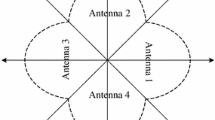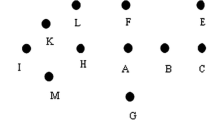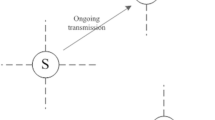Abstract
A directional antenna can bring benefits in terms of power consumption, spatial reuse, etc. To exploit the advantage of directional antennas and improve the transmission throughput highest, this paper proposes an adaptive directional MAC protocol (ADMAC). By varying the transmission strategy according to the usage of the channel, nodes can send RTS and CTS packets omni-directionally or directionally. Also, this paper proposes a calculation method of virtual carrier sensing with collision avoidance. By the method, ADMAC protocol makes more pairs of nodes transmit and receive data simultaneously without interferences than other MAC protocols for directional antennas. The paper compares the simultaneous delivering nodes and network throughput of ADMAC with DMAC, DVCS and SDMAC under different experiment parameters. The simulation results show that the throughput of ADMAC is higher than the throughput of DMAC, DVCS and SDMAC protocols.
Similar content being viewed by others
References
Stimson G W. Introduction to Airborne Radar. Mendham: Scitech Pub Inc, 1998
Hill J E. Gain of directional antennas. Watkins-Johnson Company Tech-notes, 1976
Rappaport T S. Wireless Communications: Principles and Practice. Upper Saddle River: Prentice Hall, 1996
Spyropoulos A, Raghavendra C S. Energy efficient communications in ad hoc networks using directional antennas. In: Proceedings of IEEE INFOCOM, New York, USA, 2002
Nasipuri A, Li K, Sappidi U R. Power consumption and throughput in mobile ad hoc networks using directional antennas. In: Proceedings of IC3N, Miami, USA, 2002
Yi S, Pei Y, Kalyanaraman S. On the capacity improvement of ad hoc wireless networks using directional antennas. In: Proceedings of ACM MobiHoc, Annapolis, USA, 2003
Liu B, Liu Z, Towsley D. On the capacity of hybrid wireless networks. In: Proceedings of IEEE INFOCOM, San Franciso, USA, 2003
Yi S, Pei Y, Kalyanaraman S. On the capacity improvement of ad hoc wireless networks using directional antennas. In: Proceedings of ACM MobiHoc, Annapolis, USA, 2003
Yi S, Pei Y, Kalyanaraman S, et al. How is the capacity of ad hoc networks improved with directional antennas? Wireless Netw, 2007, 13: 635–648
Lu X F, Towsley D, Lio P, et al. Minimizing detection probability routing in ad hoc networks using directional antennas. EURASIP J Wireless Commun Netw, 2009, doi:10.1155/2009/256714
Navda V, Subramanian A P, Dhanasekaran K, et al. MobiSteer: using steerable beam directional antenna for vehicular network access. In: Proceedings of MobiSys’07, New York, USA, 2007
IEEE Standards Working Group. Wireless Lan Medium Access Control (MAC) and Physical Layer (phy) Specifications. 1999
Shihab E, Cai L, Pan J. A distributed directional-to-directional MAC protocol for asynchronous ad hoc Networks. In: Proceedings of IEEE GLOBECOM, New Orleans, USA, 2008
Bao L, Garcia-Luna-Aceves J J. Receiver-oriented multiple access in ad hoc networks with directional antennas. Wireless Netw, 2005, 11: 67–79
Janaswamy R. Radiowave propagation and smart antennas for wireless communications. Boston: Kluwer Academic Publishers, 2001
Takai M, Zhou J, Bagrodia R. Performance evaluation of directional adaptive range control in mobile ad hoc networks. Wireless Netw, 2005, 11: 581–591
Li G, Yang L L, Conner W S, et al. Opportunities and challenges for mesh networks using directional antennas. In: Proceedings of IEEE WiMesh, Santa Clara, USA, 2005
Steenstrup M E. Neighbor discovery among mobile nodes equipped with smart antennas. In: Proceedings of Scandinavian Workshop on Wireless Adhoc Networks, Stockholm, Sweden, 2003
Nasipuri A, Ye S, You J, et al. A MAC protocol for mobile ad hoc networks using directional antennas. In: Proceedings of IEEE WCNC, Chicago, USA, 2000
Ko Y B, Shankarkumar V, Vaidya N H. Medium access control protocols using directional antennas in ad hoc networks. In: Proceedings of IEEE INFOCOM, Tel-Aviv, Israel, 2000
Choudhury R R, Yang X, Ramanathan R, et al. Using directional antennas for medium access control in ad hoc networks. In: Proceedings of ACM MobiCom, Atlanta, USA, 2002
Takai M, Martin J, Ren A, et al. Directional virtual carrier sensing for directional antennas in mobile ad hoc networks. In: Proceedings of ACM MobiHoc’02, Lausanne, Switzerland, 2002
Bao L C, Garcia-Luna-Aceves J J. Transmission scheduling in ad hoc networks with directional antennas. In: Proceedings of ACM MobiCom, Atlanta, USA, 2002
Li P, Zhai H Q, Fang Y G. SDMAC: selectively directional MAC protocol for wireless mobile ad hoc networks. Wireless Netw, 2009, 15: 805–820
Ramanathan R, Redi J, Santivanez C, et al. Ad hoc networking with directional antennas: a complete system solution. IEEE J Selected Areas Commun, 2005, 23
Daeipour E, Bar-Shalom Y, Li X R. Adaptive beam pointing control of phased array radar using an IMM estimator. In: Proceedings of American Control Conference, Baltimore, USA, 1994
Author information
Authors and Affiliations
Corresponding author
Rights and permissions
About this article
Cite this article
Lu, X., Towsley, D., Lio, P. et al. An adaptive directional MAC protocol for ad hoc networks using directional antennas. Sci. China Inf. Sci. 55, 1360–1371 (2012). https://doi.org/10.1007/s11432-012-4550-6
Received:
Accepted:
Published:
Issue Date:
DOI: https://doi.org/10.1007/s11432-012-4550-6




